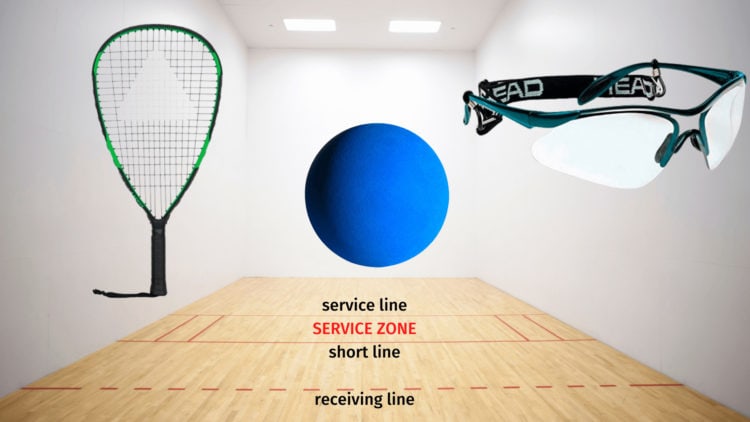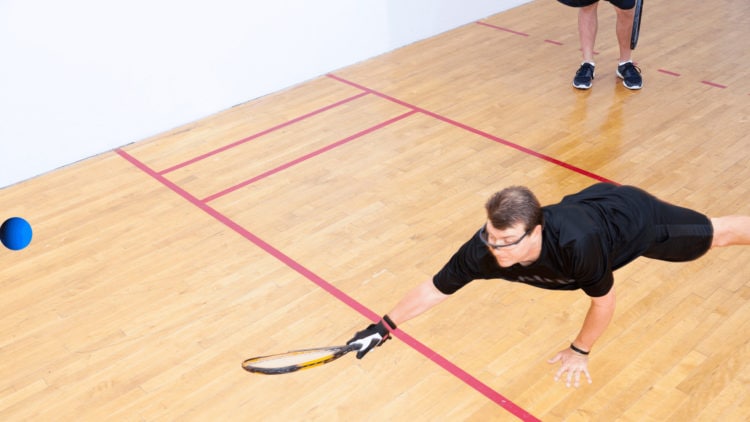
OBJECTIVE OF RACQUETBALL: Score points by hitting a ball against a wall in a manner that renders the opponent unable to return it before it bounces on the ground twice.
NUMBER OF PLAYERS: 2 or 4 players (singles or doubles)
MATERIALS: Racquetball, racket, eye goggles (optional)
TYPE OF GAME: Sport
AUDIENCE: 7+
OVERVIEW OF RACQUETBALL
Racquetball is a racket sport nearly identical to the games of squash and paddleball, as well as being similar to the sport of tennis. Unsurprisingly, the racquetball game was invented by a professional squash and tennis player, Joseph Sobek, in the 1950s at his local YMCA in Greenwich, Connecticut.
As an avid squash player and advocate, Sobek dreamed of ways to improve the sport. This interest led him to contact manufacturing companies from which he received numerous samples for various ball and racket designs. When all was said and done, Sobek decided on a large racket and a very bouncy ball—two additions that would make the sport of racquetball much faster than squash.
These changes were very popular with Sobek’s fellow YMCA members, leading to the people who play racquetball taking over the handball courts. Although the Greenwich YMCA didn’t promote the novel game of racquetball due to apprehensive concerns, the sport took off in popularity in nearby cities and states, eventually spreading all around the world.
SETUP

EQUIPMENT
The Racquetball: A rubber ball measuring 2.25 inches in diameter and 1.4 ounces in weight. These balls should bounce 68–72 inches high after being dropped from a height of 100 inches. Super bouncy!
The Racket: Racket frames can be constructed of any material but must not exceed 22 inches in length. Additionally, a racket should be attached to a player’s wrist by a wrist cord to ensure the safety of all players.
Eye Goggles: Although not mandatory, eye protection is highly recommended in competitive racquetball matches due to the speed at which the ball moves.
COURT
A racquetball court measures 20 feet in width and 40 feet in length. The court is surrounded by four high walls (the front wall, back wall, and side wall), all of which can be used during play. The service line is placed 15 feet behind the front wall. Another 5 feet behind the service line is the short line, and the 5 feet between these lines mark the service zone AKA the service box. The receiving line is a dotted line 5 feet behind the short line.
GAMEPLAY

A racquetball match begins with a player serving the ball toward the “front” wall. In a successful serve the ball hits the front wall. Then, the receiving player must return the serve to the front wall before it touches the ground twice.
The racquetball can bounce off of as many walls as necessary as long as it doesn’t bounce on the floor twice before being returned to the front wall. Technically, this means that a player can hit the ball as often as needed as long as it doesn’t hit the ground twice.
SCORING
Like squash, players don’t necessarily “score” points but rather “win” serves. In other words, only the player who serves the ball can score a point. The server can win a serve when the opposing player is unable to legally return the ball to the front wall before the ball bounces twice. The player who receives the serve cannot gain a point by winning a rally, although they do earn the next serve and do not concede a point by doing so.
Racquetball matches are frequently played in a best-of-three format, with one “match” consisting of the two or three “games” played within it. Games are won by the first player to reach 15 points, although this target number drops to 11 points in the tiebreaker game (game three).
DOUBLES
The game of racquetball can be played with two players (singles) or four players (doubles). Despite doubling the players, there are no significant changes from the basic rules between the two methods of playing other than minor changes regarding how the ball will be served. In a doubles game, the teammates decide who will serve first, and then they will alternate serves.
SERVING AND RECEIVING RULES
- When serving the ball, a player must let it bounce once on the ground before hitting it toward the front wall.
- A served ball must hit the front wall first; furthermore, its rebound off the wall must land beyond the designated “short line” to count as a sufficient serve.
- The receiving player must wait behind the “receiving line” while awaiting the serve.
- After serving or receiving the ball, the player must move out of the way of the ball’s trajectory. If a player fails to do so, resulting in an obstruction of their opponent’s view or ability to hit the ball, a “hinder” is called. This results in replaying the serve, except in the case where the hinder took away a possible point.
Want to check out an example of a rally? Check out this awesome rally in the video below!
Racquetball Rally Clip – Gaming Changing Rally!
END OF GAME
The first player/team to reach the target score in two of the three racquetball games is deemed the winner of the match.
- 30 GAMES TO PLAY OVER TEXT - April 22, 2024
- 20+ FREE PRINTABLE BABY SHOWER GAMES - April 16, 2024
- 20+ College Party Games for the Best Night Ever! - April 2, 2024